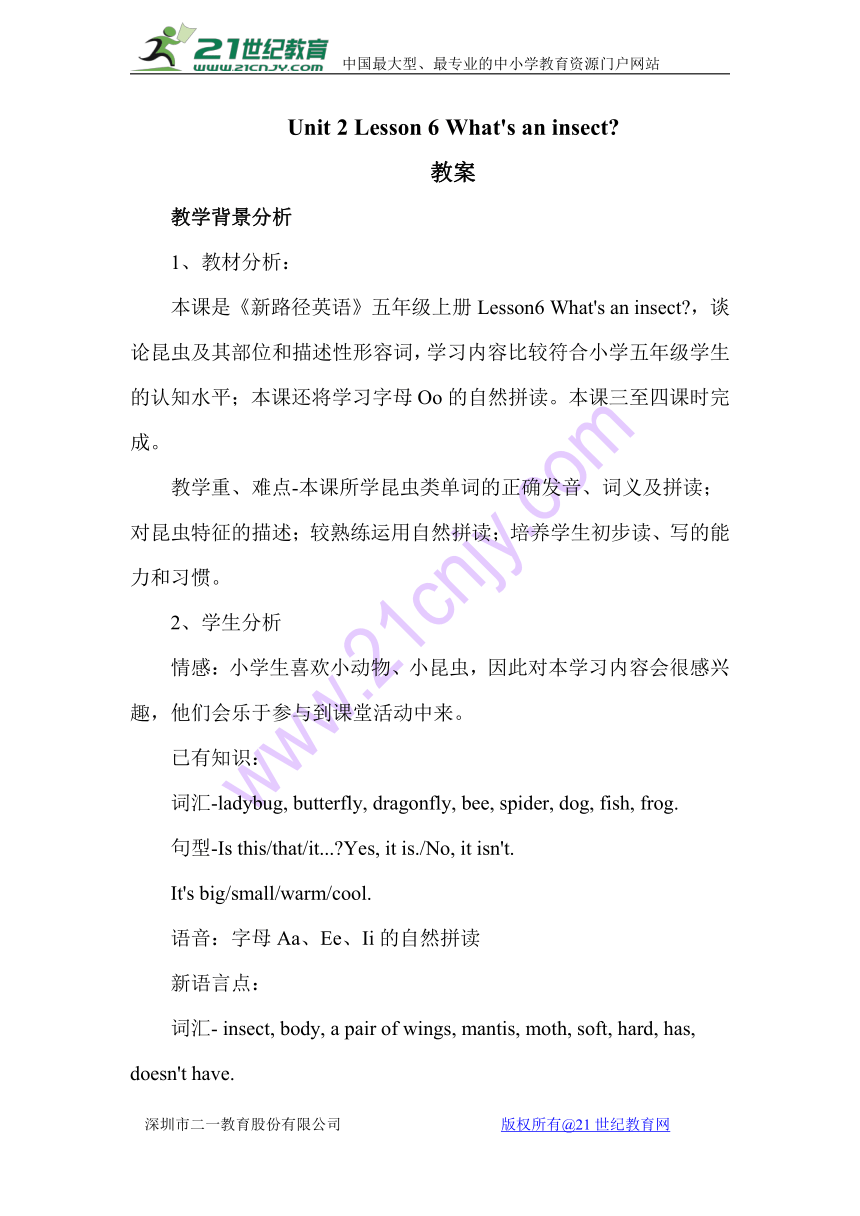
Unit 2 Lesson 6 What's an insect? 教案 教学背景分析 1、教材分析: 本课是《新路径英语》五年级上册Lesson6 What's an insect?,谈论昆虫及其部位和描述性形容词,学习内容比较符合小学五年级学生的认知水平;本课还将学习字母Oo的自然拼读。本课三至四课时完成。2·1·c·n·j·y 教学重、难点-本课所学昆虫类单词的正确发音、词义及拼读;对昆虫特征的描述;较熟练运用自然拼读;培养学生初步读、写的能力和习惯。【来源:21·世纪·教育·网】 2、学生分析 情感:小学生喜欢小动物、小昆虫,因此对本学习内容会很感兴趣,他们会乐于参与到课堂活动中来。 已有知识: 词汇-ladybug, butterfly, dragonfly, bee, spider, dog, fish, frog. 句型-Is this/that/it...?Yes, it is./No, it isn't. It's big/small/warm/cool. 语音:字母Aa、Ee、Ii的自然拼读 新语言点: 词汇- insect, body, a pair of wings, mantis, moth, soft, hard, has, doesn't have.21世纪教育网版权所有 句型-Is it a/an...? Yes, it is./No, it isn't. It has... It doesn’t have… 语音:字母Oo的自然拼读。 教学目标设定 语言知识: 语音-学生较熟练地运用自然拼读法的法则拼读字母Oo在单词中的发音。词汇-学生熟悉掌握昆虫的单词、发音、词义及拼读;理解和领悟词语、对话及故事;能运用词汇对昆虫特征的描述。 语法-学生熟练应用句型Is this/that/it...? 及其答语Yes,it is./No,it isn't.会用has及否定形式doesn't have。21cnjy.com 语言技能: 听做-学生能在图片的帮助下听懂课文对话;能根据听到的词语识别图片或单词;能听懂简单的录音材料并排序。21·cn·jy·com 说演-学生能根据录音模仿说英语;能根据图、文说出单词或句子;能就课文对话内容、故事做角色表演;能说本课歌謡;口头表达中做到发音清楚,语调达意。21教育网 读写-学生能根据拼读的规律,读出简单的单词;能在图片的帮助下认读单词、句子;能在借助图片读懂简单的小故事或小短文;能读懂教材中简短的要求或指令;能根据要求书写单词。 情感态度: 1.乐于模仿,敢于开口,乐于参与英语实践活动,让学生继续保持对英语的学习兴趣。 2.能在小组活动中积极与他人合作,相互帮助,共同完成学习任务。 3.培养学生善于观察、动手动脑的习惯,培养学生对昆虫的兴趣和对大自然的热爱之情。 学习策略: 1.能积极与他人合作,共同完成学习任务。 2.注意观察生活。 3.注意发现语言的规律并能运用规律举一反三。 文化意思: 1.知道常见的昆虫名称及特征。 教学过程(第一课时,学习内容:Let’s talk. Work in pairs.) Warm-up Greetings. Duty report. Let’s chant: High and low. Review and lead-in. 1.(Show some insects of cards.)Ask questions. T: What’s this in English? Is this/that…? butterfly Ss: It’s a dragonfly daddy bug spider It’s an ant. T: What are these? They are insect. T: What’s ‘insect” in Chinese? What's an insect? Today We are going to learn Lesson6. What's an insect?(板书课题) Presentation (Let’s talk) 1. Play the tape twice. Touch and listen. 2. Question: What's an insect? 3. Explain: nothing, has, body, a pair of wings, most of them. Oh, I see. Listen and repeat twice. Work in groups. Act it out. Practice (Work in pairs) 1. Silent reading. 2. Guess: What is the difference? 3. Work in pairs. 4. Touch and say and act in class. Homework: 1. Listen and read. 2. Make an insect specimen. ... ...
~~ 您好,已阅读到文档的结尾了 ~~

